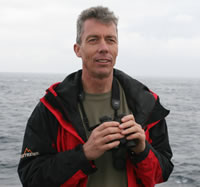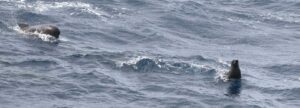ACE birders’ blog – Leg 1, Day 28

By Peter Ryan, onboard scientist, expert in general ornithology, seabird-fishery interactions, evolutionary ecology, marine debris, solid waste management, biology of oceanic islands.
Leg 1, Day 28.
Four weeks at sea have flown by, and today the ACE birding team celebrated 5000 km of at-sea transects. By the end of the day we had counted the birds, marine mammals, kelps and rubbish drifting across 5214 km of Southern Ocean, during almost 210 hours of transects since leaving Cape Town late on 20 December. Today was another fairly slow day, but bird diversity picked up a bit compared to the last few days, and 15 species were seen:
| Short-tailed Shearwater | 170 | White-headed Petrel | 38 |
| Fairy Prion | 13 | White-chinned Petrel | 10 |
| Antarctic Prion | 10 | Wandering Albatross | 3 |
| Shy Albatross | 3 | Mottled Petrel | 2 |
| Southern Royal Albatross | 1 | Grey-headed Albatross | 1 |
| Northern Giant Petrel | 1 | Diving petrel spp. | 1 |
| Grey-backed Storm Petrel | 1 | Brown Skua | 1 |
| Soft-plumaged Petrel | + |
Short-tailed Shearwaters were the most abundant species, thanks largely to a flock of 120 foraging birds, but White-headed Petrels were the most regularly encountered species for the third day in succession. Interestingly, the proportion of moulting birds has decreased steadily as we progressed northeast. Tomorrow we shall enter the waters close to Tasmania and we expect a further increase in species richness, as we encounter more productive coastal waters.
Jasmine got to pick the pic of the day, and predictably was entranced by the ‘cute’ fur seal with one of the two pods of Long-finned Pilot Whales seen toady. Bull Kelps were even more abundant today than the last few days, with an average of 17 kelps per 100 km of transects. Almost all plants were heavily encrusted with goose barnacles, with large clusters of barnacles weighing down the ends of many fronds. One litter item was seen (a small plastic fragment), but three 20-litre bucket samples at the CTD station confirmed the abundance of fibres and other small microplastics in surface waters.
